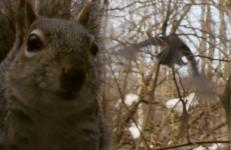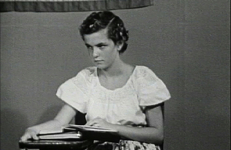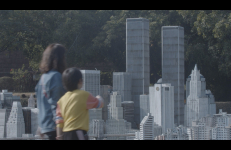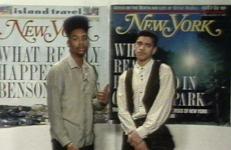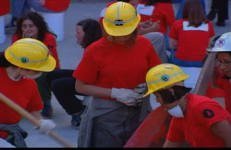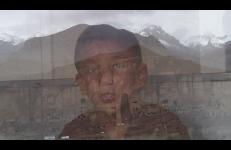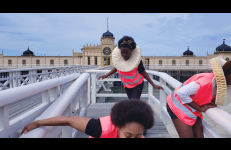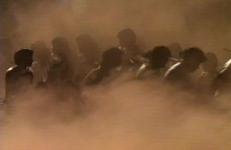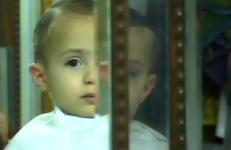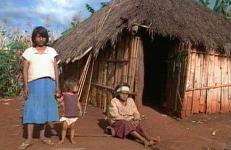Songs of Praise for the Heart Beyond Cure is a fourteen-minute experimental video that unfolds through a series of short episodes. "To describe Cooper Battersby and Emily Vey Duke's new video as ironic doesn't do it justice.
Youth/Childhood
Told through the voices of three elderly South Carolinian's who reside in the homes in which they were born, Steven Go Get Me A Switch is an oral history mapping dichotomies of gender, familial mythologies, sexuality, and belief. A heavy use of symbolism comingles with suggestions of narrative proof. The desire to be good and the impossibility of such desire becomes a sharp inaudible pitch, like a dog whistles call to violence.
Invoking Eve’s temptation and fall from grace with recurring images of the garden, the serpent, and the apple, Condit provides a look at the trouble beneath the surface in a modern-day suburban paradise. As a housewife struggling to come to terms with the conflicting demands placed on her as a wife, mother, career-woman, and daughter, Anne finds she is divided against herself; her identity is a territory occupied by everyone’s needs but her own.
talkin' 'bout droppin' out examines the multiple reasons why 40% of students in New York, Boston, and Chicago drop out of high school each year. Students wrote, directed, shot and edited segments of the video with Miller’s technical and creative guidance. Jail, work, vocational school, problems with teachers, motherhood, easy money, drug or alcohol addiction, and boredom are just some of the reasons given for dropping out. Leverock Hazell (a Madison High School Graduate) composed original music for the piece, incorporating fifteen hours of the students’ taped conversations.
Why do teenagers get drunk?
"Like Gaijin, these five videos were made very quickly. My goal was to make all five of them in the span of a workweek, one video a night. If I remember correctly, I succeeded with all but one of them (it took me a few nights to get The Biggest Night in Music just right). These videos were commissioned for and premiered in the April-May 2004 Dialogue with Pop exhibition at NYC’s The Tank."
A troubling relationship arose between the character played by Winona Ryder in the film Girl, Interrupted, the genuine depression experienced by the actress, and the shoplifting of which she was accused. Consisting entirely of clips from existing films, this video essay, which ultimately turns out to be profoundly personal, explores the possible links between depression and kleptomania.
A personal essay about connection and disconnection, in and through different realities.
Time Bomb tells the story of a young girl's experience at a Baptist retreat, where she is called upon to accept Jesus into her life after a coercive game of terror. This piece explores memory, the power of crowds, rituals of conversion, and the isolation of a child lost in the world of adults. Fear and family values motivate action and create an empty arena for escape. Visually, Time Bomb proceeds through a sequence of images that figure the "light" of memory as simultaneously revelatory and obscuring, constructive and destructive.
Time Bomb tells the story of a young girl's experience at a Baptist retreat, where she is called upon to accept Jesus into her life after a coercive game of terror. This piece explores memory, the power of crowds, rituals of conversion, and the isolation of a child lost in the world of adults. Fear and family values motivate action and create an empty arena for escape. Visually, Time Bomb proceeds through a sequence of images that figure the "light" of memory as simultaneously revelatory and obscuring, constructive and destructive.
Using Paper Tiger's unique style of direct address and deconstruction, teenagers from the Bronx ask questions and try to understand the persistence of racial violence in the 1990s. Black and Latino students give a sharp and insightful comparative analysis of the newspaper coverage of two events that were especially traumatic for their community: the January 1990 murder of Yusuf Hawkins by a mob of 30 whites in Bensonhurst, and the Central Park "gang rape" of a white woman by a group of black youth.
Back in the days of hippy bliss, Ulrike and her husband used to believe that the world would be revolutionized by their activities, consisting mainly of smoking pot and having sex. Thanks to a large family fortune, none of them has ever had to work for a living. But the ‘three generation millions’ – one generation makes it, the second maintains it and the third generation blows it – are slowly disappearing. So now the burden of maintaining the tower falls on the children, of whom Sirius (the Latin form of Osiris) actually seems to enjoy making money.
A rockin’ talkin’ pony and its human companion examine the evolution of Halloween games, from the ancient rite of bobbing for apples to the contemporary spectacle of American football. Confronting liminality on 3rd down and long, the pony BRINGS IT TO THE HOUSE.
This title is also available on Ben Coonley: Trick Pony Trilogy.
Produced and directed by Darlene Haber/MediaVision, executive director, Suzanne Lacy.
From a performance by Suzanne Lacy with Barbara Clausen and thirty young women from Vancouver Canada, 1997-98.
Joe Gibbons plays Dr. Joe Baldwin, the self-styled child education expert. He prepares Zoe, from birth, for acceptance into a coveted “gifted-only” kindergarten program. He brings to each lesson an assortment of modified educational books, games and toys. These sessions, along with monologues analyzing her development, are recorded in hopes of proving that “genii [his term] are not born, but made.” What becomes evident is one man’s misguided quest to manipulate pitted against one child’s exuberant resistance to being controlled.
Director’s statement:
U & I dOt cOm is an experimental narrative/documentary hybrid about Zoey, a teenage girl who negotiates her identity in cyberspace. Dreaming about the perfect true love, she secretly navigates 3-D worlds to find romance. A web contest sweeps her into a dreamscape of desire and deception as hidden mechanisms of e-commerce, online data-mining, and real-time consumer profiling monitor her every move. When Zoey finally rebels, her sense of self, her home, and her relationship with her mother are forever transformed in the new cyber-cultural domain.
Out of the mouths of rural boys, finding the incomparable Mulla Nasrudin in Afghanistan.
Filmed entirely in Sweden, VIEWFINDER is a surreal sound-film that entangles gestures of place, belonging, and monument. Informed by archival research, oral history, and folk stories, the film focuses on Black immigrants who have recently migrated to Sweden. These performers enact dance-like choreographies in critical sites across the coastal town of Varberg, generated in response to an absence of Black life found in the municipal archives.
Within the long cycle of initiation ceremonies of the Xavante People, the Wai’a celebration introduces young men to spiritual life and puts them in contact with supernatural forces. Filmmaker Divino Tserewahu speaks with his father (one of the leaders of this ritual) about what can be disclosed of this secret celebration of men, where the initiated go through many trials and tribulations.
Directed by Divino Tserewahú.
In Xavante with English subtitles.
A documentary about the initiation ritual for young Xavante Indians, created during a training workshop for the Video in the Villages project. Invited by Divino from the Sangradouro village, one Suyú and four Xavantes Indians film together for the first time. While filming the ritual, various members of the village explain the significance of the complex ceremony’s elements.
Directed and photographed by Bartolomeu Patira, Caimi Waiassé, Divino Tserewahú, Jorge Protodi, Whinti Suyá; edited by Tutu Nunes.
In Xavante with English subtitles.
We will live to see these things... is a documentary video in five parts about competing visions of an uncertain future. Shot in 2005/06 in Damascus, Syria, the work combines fiction and non-fiction. Each section of the piece--the chronicle of a building in downtown Damascus, an interview with a dissident intellectual, documentation of an equestrian event, the fever dream of a U.S.
We will live to see these things... is a documentary video in five parts about competing visions of an uncertain future. Shot in 2005/06 in Damascus, Syria, the work combines fiction and non-fiction. Each section of the piece--the chronicle of a building in downtown Damascus, an interview with a dissident intellectual, documentation of an equestrian event, the fever dream of a U.S.
I could not remember anything about my childhood before the age of twelve. I made a decision to remember. West Fingerboard Road relays how I remembered my forgotten childhood memories, and references the writings of philosopher Gilles Deleuze that echo my ideas on memory and the process of remembering.
-- Susan Youssef
This moving video portrait follows a group of teenage boys who attend the Masada School, a school for juvenile delinquents and social misfits. The boys worked on every phase of the video, and present a picture of themselves that challenges society’s, and their own, typecasting. The humor, philosophy, and honest retelling of the students’ stories details the Catch-22 of living on the street, how parents' problems are passed on to the boys through abuse and neglect, and the struggle each feels to keep hope for a better life.
In this wistful tape, Segalove looks at how her childhood vision of the future holds up (or doesn't) in adulthood. Commissioned by the Los Angeles County Museum of Art.
Indians In Brazil is an educational series for Brazilian public schools that invites students to experience cultural diversity. Four teenagers are invited to discover a new world and participate in Indian daily life in two different communities. They show their emotions, curiosity and fears, and are surprised by their new friends. Part Two of the series, When God Visits the Village, sees the teenagers invited to visit the Kaiowá people in South Mato Grosso. Expecting something similar to the Krahô village they had earlier visited, they are at first shocked.




